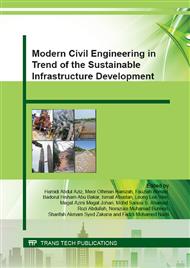p.184
p.190
p.196
p.202
p.208
p.214
p.220
p.225
p.231
Influence of People Walking on Floor Performance due to Low Level Vibration
Abstract:
Abstract. Vibration in building is one of the important problems which need to consider, especially in designing the floor. Floor vibrations are generally caused by dynamic loads applied particularly by human activity especially walking. Although it is specified as low level amplitude, walking induced vibrations can cause discomfort to human occupants and alarming for a certain items of precision sensitive equipment. This paper investigates the vibration response on floor performance due to one, three and five of people walking. Laser Doppler Vibrometer was used to obtain vibration data when people are walking. Further analysis was carried out by using finite element software package ANSYS to simulate the floor under vibration inputs to obtain natural frequency and mode shapes of the floor structure. The vibration data was then analysed in ModalV analysis to generate the vibration response. Then, the results were checked against the vibration criteria level guideline as a crude tool comparison. As a result, the numbers of people walking were influenced the floor performance, which indicated five peoples walking show the highest response up to ISO level due to vibration compared with one people walking.
Info:
Periodical:
Pages:
208-213
Citation:
Online since:
October 2015
Price:
Сopyright:
© 2015 Trans Tech Publications Ltd. All Rights Reserved
Share:
Citation:


